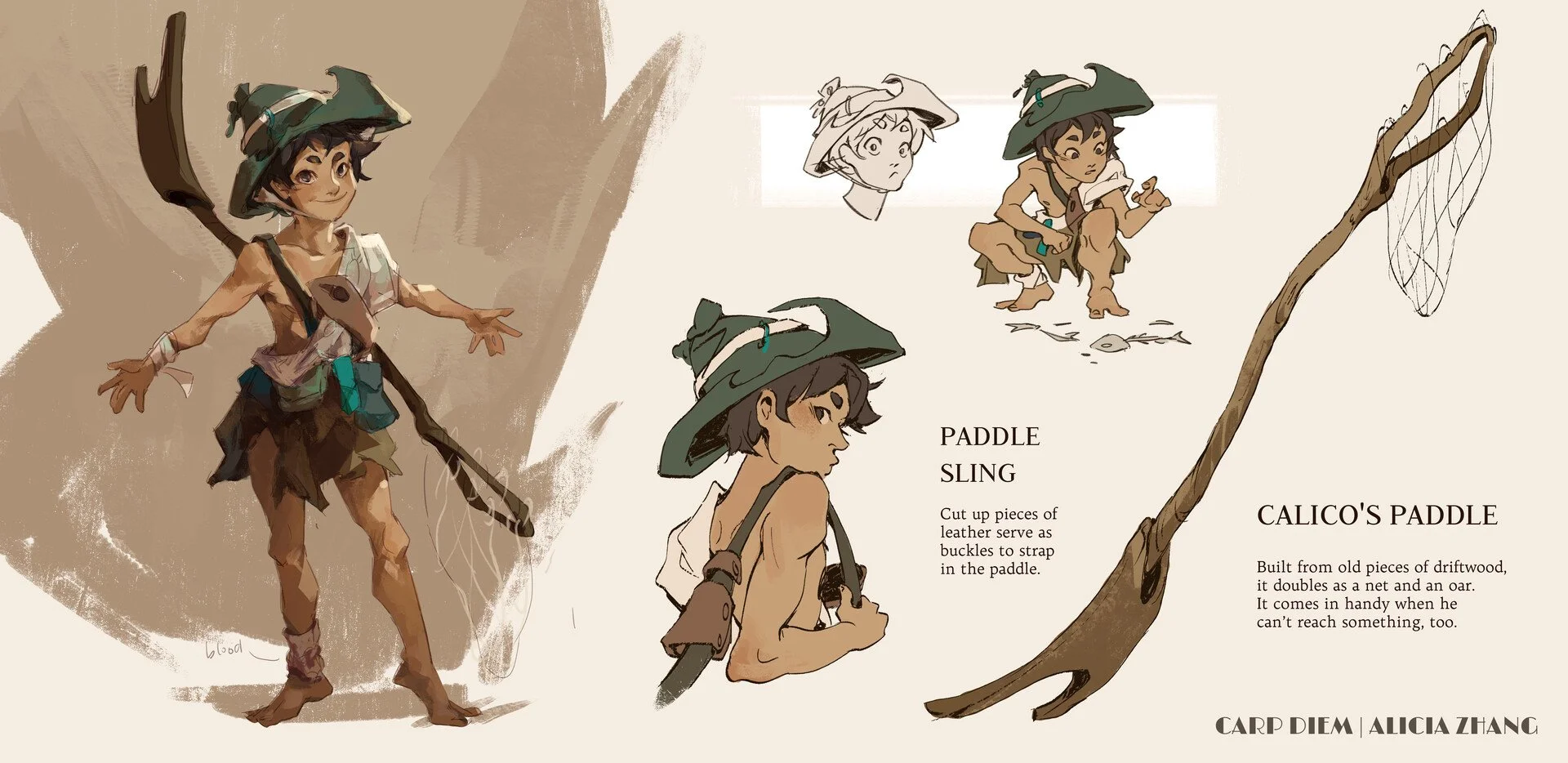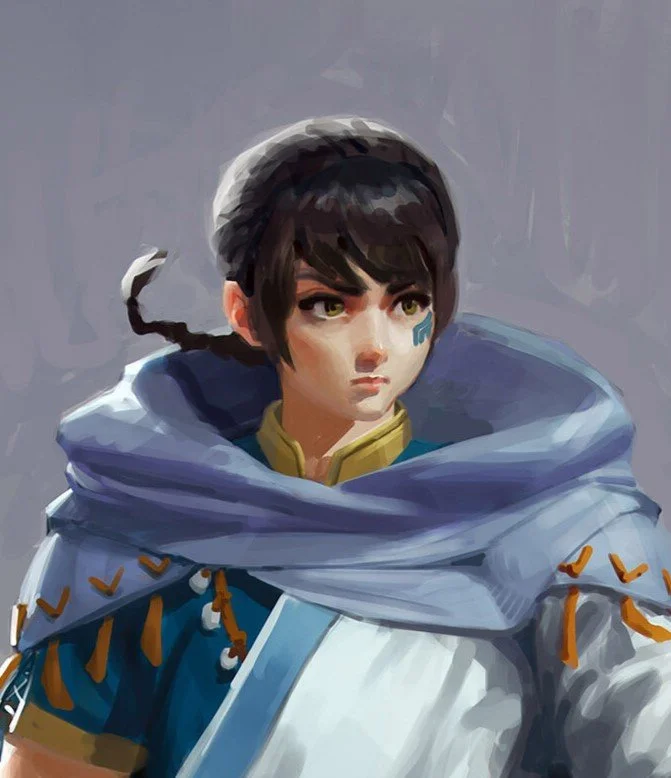Questions, Brushes, Teaching, and More
FAQs
What program/equipment do you use?
I use Photoshop, Clip Studio Paint for programs.
For my equipment, I use an Intuos Pro Medium, a Cintiq, and a Samsung tablet
What brushes do you use?
Typically, I only offer my brushes to students attending my workshops, or taking my class at Schoolism.com. If you’re looking for some of my favorites though, I LOVE Sergey Kolesov’s brushes. Some of my most-used brushes are still his brushes!
What school did you go to?
I attended the ArtCenter College of Design as an Entertainment Design Major, starting in Fall 2018
What stationary do you use?
You can watch a list of my favorite stationary here!
Are you available for mentorships?
I’m thrilled by your interest! But I currently do not have the availability to take on students. If I do mentorships, you’ll see an announcement on my social media
Are you available for commissions?
I currently do not accept personal commissions outside of contract work. If I do commissions, you’ll see an announcement on my social media
What sketchbook do you use?
I use a 5 x 5 Talens Artcreation sketchbook. It’s my favorite! You can see me talk about it here
Where can I buy prints?
Happy you’re looking for prints! I partner together with Gallery Nucleus who prints on beautiful archival watercolor paper for stunning fade-resistant pieces. You can purchase here
How do I?…
I often get asked questions regarding concept art, painting, school, and I hope that your burning questions and more, can be answered here!
-
That’s a really broad start because there's a ton of TYPES of concept art out there! Just like there’s all kinds of doctors from dermatologists to heart surgeons.
First off, figure out what kind of art YOU enjoy making. It's like choosing your art specialty, just the first step, takes time to discover. Dive into research, check out different companies, see what job your favorite artists have, and see what clicks.Second, once you've decided a direction, you need a portfolio! These days, a website is the golden ticket – PDFs are more for established artists . You can easily make a portfolio through Artstation, that’s what most recruiters use.
Last but not least, network like it's a sport. You can find lots of communities easily through Discord, the Lightbox Expo discord is a great place to start. Connections are also a part of your art superpower!
So, in a nutshell: Determine your passion, build a killer portfolio website, and get out there and mingle. You got this! 🎨✨
-
The easy answer: practice, practice, practice.
But you might be wondering, what’s the most effective way??? If you ask me, my go-to? Analog drawing – Traditional drawing with pencils, paper, and paint. Lots of drawing from life, feeling that pencil on paper, and having to actually mix paints for color, fast-tracks improvement. The fastest people I’ve seen get good at 2d art, did gouache, acrylic, charcoal, pastel, crayon, marker etc.
It's like a creative workout, if you can flex those artistic muscles daily, and you'll see the gains. Don't just stick to your comfort zone – challenge yourself with new subjects and styles. With every piece I do, I try to tackle something I haven’t tried before, whether it’s a new angle, or a new kind of subject matter. So, grab your tools, and go get that art bread! 🎨✨
-
I think something that really opened my eyes, was the quote “motivation does not inspire action, ACTION inspires motivation” and that is SO true. Sometimes I wake up and the last thing I want to do is draw.
But if I just open a blank canvas…. let it sit for a while… I feel very very compelled to do SOMETHING. I’ll tell myself “ok all you need to do is ONE paint stroke” and usually, that’ll lead to 3-4 more.. then an hour has passed!However, if you’re MAJORLY burned out, you are exhausted everyday and you’d rather eat a brick, then that’s your body telling you, you need a genuine break. Go to sleep. Listen to music and take a long walk. Taking a break does not mean rolling for gachas or scrolling mindlessly on social media. It means giving your body and mind some genuine quiet and rest.
If you truly love art, and you allow your body to rest, your motivation will always run back to you :) -
My best advice: Have a colorful DIET! (not vegetables or fruit, obviously eat that too but-) I mean what you look at! If you want better color, make sure to have SUPER colorful references alongside you, and try to emulate their color palettes! Look for beautiful colorful pieces you like, and seek good color out. Your eye will naturally start to implement color into your own work.
I prefer a hands-on approach when it comes to color, and I love looking at colorful things, and then trying to recreate its palette on my own piece. This could be photographs of cool beads, the palette of socks, or film scenes. Interior designers, UI/UX, food videography, Banana Repubic’s photoshoots, good color palettes are everywhere.
If you prefer a more technical approach, I know that James Gurney's Color and Light is a fantastic book, so if you're an avid reader, that book is a great resource!I do teach color specifically in my class via Schoolism where I specifically dive into my approach. As much as I'd like to try and explain it in this tiny paragraph, it genuinely is too difficult without visuals.
-
My personal recommendation when it comes to painting, is to start traditional, whether it's oil, watercolor, or gouache! Because that's the fastest way to train your eye to proper color and value; it's very difficult to mix all the colors physically, but you learn very quickly, much more than digital alone.
Start small by painting things like a single tree, a flower, and slowly move to the bigger things like cities or forests. It's like learning to dance, you have to know how to walk and run properly first, so don't worry if you can't draw an entire castle right away.
If you want to see how I paint more in-depth, I break it down in my class via Schoolism, just know it’s purely digital painting!
-
For studies: Film studies of your favorite cinematographers. Just pause the screen, and ask yourself “where is the horizon line? Are the character above, or below it? How big is the character compared to the environment?”.
For your sketchbook: A good rule of thumb is to visually divide your sketchbook page into 2-3 parts, and try to fill each of the parts with something different. Have one thing on your page be the center focus, and everything else
For life: Look for things with good composition. First RECOGNIZE good composition. Not just in art, but in magazines, or youtube video placement, the setting of the dinner plates at your table. If you want to NATURALLY improve your composition, first recognize whenever things around you are placed in ways that make you feel something. Messy desk makes you feel uncomfortable? Socks draped over a thin telephone wire funny? Note it down!! That’s composition!!!!
For the hardcore: Study graphic design ;) No one else drills hierarchy better than graphic designers
-
This is so dependent on which art school you choose, and how much money you have. I PERSONALLY really loved my experience at ArtCenter. But I know many people who hated their experience there too.
I think it’s a good choice for people who thrive in a structured setting, and want an in-person environment with other creatives. If you far prefer doing your own thing and going solo, mayyyyybe it isn’t for you.
My biggest advice for anyone at art school is to be proactive about your education. Apart from your regular coursework, it's also essential to take additional extra-curricular activities that can help you build skills and expand your knowledge base. All of the people I know who got jobs right out of school, ALL did extra studying on top of their typical schooling. -
I don't think there's an easy answer to this, because everyone's life and work, are different!
So I think everyone will have their unique take. And for me, that means finding hobbies that are very removed away from art, like hiking or cooking. Just doing art is really exhausting, but it can be doubly exhausting if you're expecting yourself to also draw more fun art on top of it.
I found that letting go of expectations that you should always be drawing brought the joy of it back :) -
Well it all depends on what you want that portfolio for! Is it for props, or environments, or color, or…??? Recruiters’ top comments on portfolios are usually that they prefer to see a specialty in a portfolio.
Here’s some advice for ALL portfolios though: Make it EASY to look through! Put it onto a website, or compile it into an Artstation. Long gone are the age of pdf portfolios in my opinion.
Also, don’t label anything as school work! Just say the name of the project.
Concept Painting Class
My personal concept painting class, hosted through Schoolism because I, myself, took Schoolism to learn art when I was starting out! I teach all the techniques that I use and implement today.




